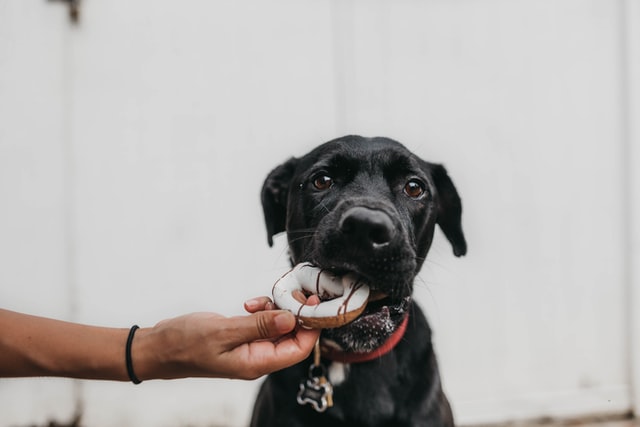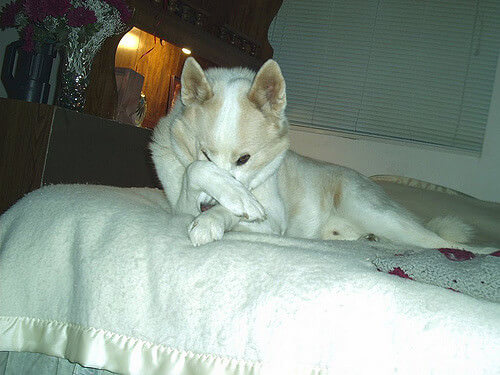Listen up, pet parents: Your fur baby is trying to tell you something important!
As pet parents, we want to keep our fur babies happy and healthy, as well as give them what they want and need. Unfortunately, that whole “language barrier” thing can sometimes make it tricky to figure out exactly what that is. So, how can you deftly navigate your way through the world of canine communication?
Generally, there are three primary ways that you can tell when a dog needs your help: physiological changes, behavioral changes, and signs of pain or discomfort. To be honest with you n#2 shocked me as well
5- Eating and drinking differently

“A sudden and unusual change in activity is one of the first signs that your dog isn’t feeling well and may need help,” says Jesus Aramendi, DVM, a veterinarian at Chewy. This is especially true if those activities are vital to their survival. If your dog has lost his appetite, is suddenly ravenous, or is drinking far more or far less water than usual, it’s time for a check-in. Sometimes, these signs can be subtle. Dr. Aramendi says that red flags might include leaving a bowl full of food or water, not being as excited about mealtime, or scouring the house for new sources of food and water—like, checking out your pantry for a bite or heading to the toilet for a drink.
Here’s the good news: It’s possible that your dog might have a harmless bug passing through his system, or maybe he’s been running around more than usual and his appetite or thirst has increased accordingly. And now for the bad news: It could also be a sign of something more serious, such as Cushing’s disease, diabetes, or kidney or liver disease. If this behavior lasts more than 24 hours—or if it’s accompanied by other serious symptoms, such as vomiting, diarrhea, or whimpering—see your veterinarian. Don’t miss these other signs that your “healthy” pet is showing dog illness symptoms.
4- Change In Energy Level

Remember, the language of dogs is energy. If you notice an unexplained change in your dog’s energy level, consult with a veterinarian to assess your pup’s overall health.
Dogs are always excited when you get home. They know when you’re having a bad day, and you don’t even have to tell them. And that’s the thing. You don’t have to spell it out for your furry friend. They just know. They understand your moods without one single explanation — because they understand your energy. Cesar Millan, the Dog Whisperer, teaches that canines pay attention to energy, and that’s what they respond to. That’s why they know when you’re sad, angry, or happy. That’s their language.
3- Avoids Being Touched

Dogs might avoid being handled in certain areas if they experience pain when touched. Keep in mind your dog is programmed to not show weakness, so even though they don’t whine or whimper, they can still be in pain. Best to have your pooch checked by the vet to determine the cause of any potential pain.
2- Whining or whimpering in one spot

Has your dog ever whined or whimpered repeatedly in one area for no reason? Oh, there’s a reason, all right. Your dog wants something—you just have to figure out what it is! Perhaps there’s a ball trapped under the sofa and your pup needs you to get it. Or maybe your dog wants to go for a walk or is feeling frisky and simply wants to play.
Or if your dog is whining or whimpering next to the food bowl, it’s probably a sign that he’s ready for a little grub. If your dog is always begging for food, even when he’s been adequately fed, curb that behavior by redirecting him to play with a chew toy or snuggle with you on the couch. If the hunger is persistent, it’s time to schedule a visit to the vet. Learn more about the noises dogs make—and what they mean.
1– Rubbing his face

Owners think that a dog rubbing his face on them is a sign of affection like it is for a cat, but if your dog is repeatedly rubbing his face, there could be trouble. Something on his face is irritating or itching. He could be rubbing his eyes or ears. He might even have something lodged in his mouth and teeth. Especially if you notice the rubbing is extreme, you need a vet to help.
Dogs can rub their faces against items, like furniture or people or even with their own paws. Sometimes the rubbing becomes excessive enough to rub the hair away around the eyes or you might notice some other symptoms. Report everything you notice to your vet. There are things that can done to check for a corneal (eye) scratch and certainly you need to know for sure if your dog’s ears are alright and make sure there is nothing lodged in the mouth. Dogs that frantically rub their faces along the grass or constantly paw are doing so for a reason. Tell your vet.
Our dogs make us smile every day, but sometimes things we perceive as amusing can be a signal that your friend needs help. If you notice a behavior in your dog that seems too frequent, ask your vet if it should be investigated. It never hurts to ask and your dog might really thank you.
